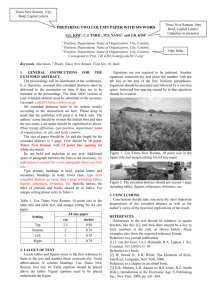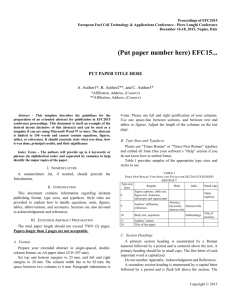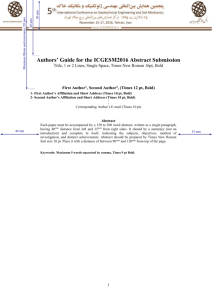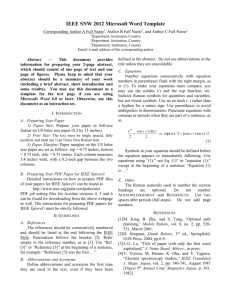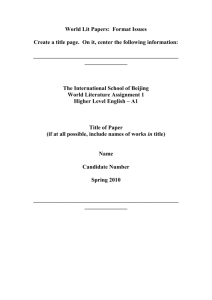Word 2003 version
advertisement
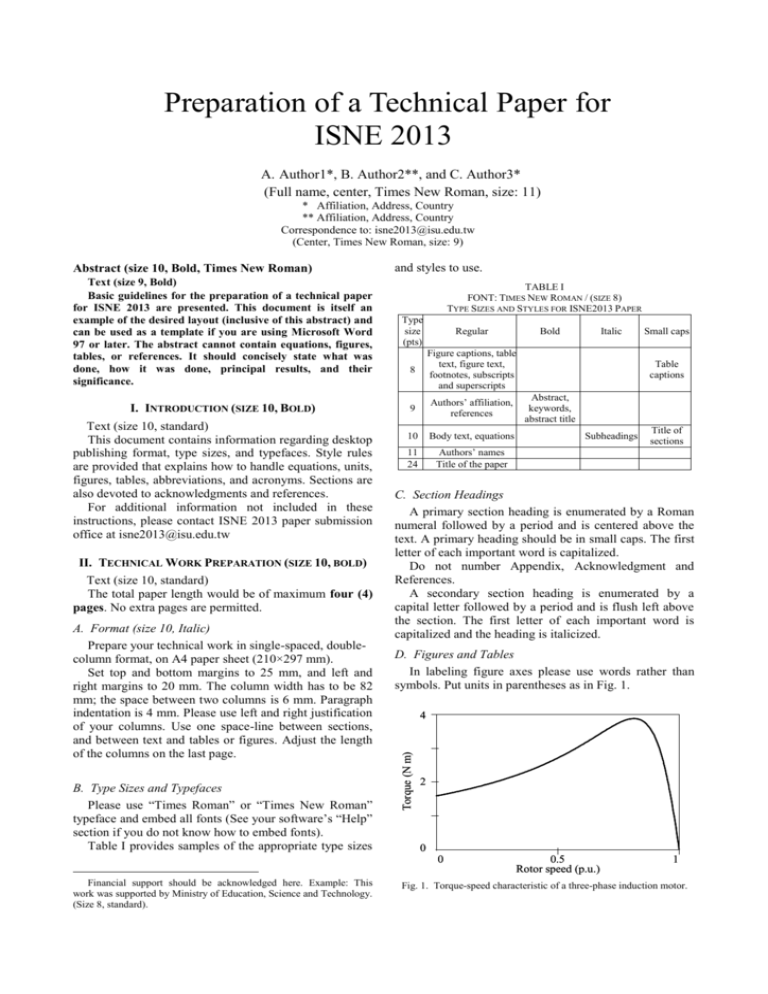
Preparation of a Technical Paper for ISNE 2013 A. Author1*, B. Author2**, and C. Author3* (Full name, center, Times New Roman, size: 11) * Affiliation, Address, Country ** Affiliation, Address, Country Correspondence to: isne2013@isu.edu.tw (Center, Times New Roman, size: 9) Abstract (size 10, Bold, Times New Roman) and styles to use. Text (size 9, Bold) Basic guidelines for the preparation of a technical paper for ISNE 2013 are presented. This document is itself an example of the desired layout (inclusive of this abstract) and can be used as a template if you are using Microsoft Word 97 or later. The abstract cannot contain equations, figures, tables, or references. It should concisely state what was done, how it was done, principal results, and their significance. Type size (pts) Regular 8 Figure captions, table text, figure text, footnotes, subscripts and superscripts I. INTRODUCTION (SIZE 10, BOLD) 9 Authors’ affiliation, references 10 Body text, equations 11 24 Authors’ names Title of the paper II. TECHNICAL WORK PREPARATION (SIZE 10, BOLD) Text (size 10, standard) The total paper length would be of maximum four (4) pages. No extra pages are permitted. A. Format (size 10, Italic) Prepare your technical work in single-spaced, doublecolumn format, on A4 paper sheet (210×297 mm). Set top and bottom margins to 25 mm, and left and right margins to 20 mm. The column width has to be 82 mm; the space between two columns is 6 mm. Paragraph indentation is 4 mm. Please use left and right justification of your columns. Use one space-line between sections, and between text and tables or figures. Adjust the length of the columns on the last page. B. Type Sizes and Typefaces Please use “Times Roman” or “Times New Roman” typeface and embed all fonts (See your software’s “Help” section if you do not know how to embed fonts). Table I provides samples of the appropriate type sizes Italic Small caps Table captions Abstract, keywords, abstract title Subheadings Title of sections D. Figures and Tables In labeling figure axes please use words rather than symbols. Put units in parentheses as in Fig. 1. 4 2 0 0 Financial support should be acknowledged here. Example: This work was supported by Ministry of Education, Science and Technology. (Size 8, standard). Bold C. Section Headings A primary section heading is enumerated by a Roman numeral followed by a period and is centered above the text. A primary heading should be in small caps. The first letter of each important word is capitalized. Do not number Appendix, Acknowledgment and References. A secondary section heading is enumerated by a capital letter followed by a period and is flush left above the section. The first letter of each important word is capitalized and the heading is italicized. Torque (N m) Text (size 10, standard) This document contains information regarding desktop publishing format, type sizes, and typefaces. Style rules are provided that explains how to handle equations, units, figures, tables, abbreviations, and acronyms. Sections are also devoted to acknowledgments and references. For additional information not included in these instructions, please contact ISNE 2013 paper submission office at isne2013@isu.edu.tw TABLE I FONT: TIMES NEW ROMAN / (SIZE 8) TYPE SIZES AND STYLES FOR ISNE2013 PAPER 0.5 Rotor speed (p.u.) 1 Fig. 1. Torque-speed characteristic of a three-phase induction motor. Large figures and tables may span both columns, but may not extend into the page margins. Figure captions have to be below the figures; table captions have to be above the tables. Do not put captions in "text boxes" linked to the figures. Do not put borders around your figures. All figures and tables must be placed just after they are first mentioned. Digitize your tables and figures. Acknowledgment. E. Numbering Do not number pages. Number reference citations: consecutively in square brackets [1]. Number footnotes separately with superscripts. Place the actual footnote at the bottom of the column in which it is cited. All figures and tables must be numbered consecutively. Use Arabic numerals for figures and Roman numerals for tables. List only one reference per reference number according to the following samples: F. Abbreviations and Acronyms Define less common abbreviations and acronyms the first time they are used in the text, even after they have been defined in the abstract. Do not use abbreviations in the title unless they are unavoidable. G. Math and Equations Use either the Microsoft Equation Editor or the MathType commercial add-on for MS Word for all math objects in your paper. Number equations consecutively with numbers in parentheses flush with the right margin, as in (1). Be sure that the symbols in your equation have been defined before the equation appears or immediately following. v s Rs i s Ls d d i s Lm i r dt dt (1) where Rs is the stator phase resistance. III. UNITS (SIZE 10, BOLD) Use International System of Units (SI - MKSA) as primary units. British units could be used as secondary units in parentheses. IV. CONCLUSIONS (SIZE 10, BOLD) Conclusions are one of the most important parts of a paper. Please give careful consideration to this section. Papers submitted to ISNE 2013 will automatically be published on IEEE Xplore. Once complete to write a paper, authors must create a PDF according to the IEEE PDF Specification for IEEE Xplore. All submissions MUST be IEEE Xplore compliant and the only way to insure this is to use IEEE PDF press. Once authors have completed this step, they then can move on to the submission site and submit the paper APPENDIX (SIZE 10, BOLD) Appendixes, if needed, have to appear before the ACKNOWLEDGMENT (SIZE 10, BOLD) Please place an eventual Acknowledgment here, before the References. Put sponsor acknowledgments in an unnumbered footnote on the first page. REFERENCES (SIZE 10, BOLD) [1] G. Eason, B. Noble, and I.N. Sneddon, “On certain integrals of Lipschitz-Hankel type involving products of Bessel functions,” Phil. Trans. Roy. Soc. London, vol. A247, pp. 529-551, April 1955. [2] J. Clerk Maxwell, A Treatise on Electricity and Magnetism, 3rd ed., vol. 2. Oxford: Clarendon, 1892, pp. 68-73. [3] I.S. Jacobs and C.P. Bean, “Fine particles, thin films and exchange anisotropy,” in Magnetism, vol. III, G.T. Rado and H. Suhl, Eds. New York: Academic, 1963, pp. 271350. [4] K. Elissa, “Title of paper if known,” unpublished. [5] R. Nicole, “Title of paper with only first word capitalized,” J. Name Stan. Abbrev., in press. [6] Y. Yorozu, M. Hirano, K. Oka, and Y. Tagawa, “Electron spectroscopy studies on magneto-optical media and plastic substrate interface,” IEEE Transl. J. Magn. Japan, vol. 2, pp. 740-741, August 1987 [Digests 9th Annual Conf. Magnetics Japan, p. 301, 1982]. [7] M. Young, The Technical Writer’s Handbook. Mill Valley, CA: University Science, 1989. [8] J. Du and H. Ohsaki, “Numerical analysis of eddy current in the EMS-maglev system.” Proc. of 6th Int. Conf. on Electrical Machines and Systems (ICEMS 2003), Beijing (China), Nov. 2003, pp.761-764.
